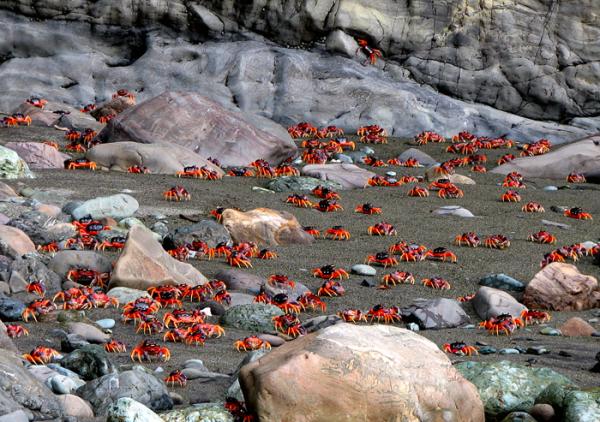
A Panamanian Crab Mystery is Solved

Scientists have documented the early stages of the life of the brilliantly colored Panamanian land crab for the first time.
The crabs (with the scientific name Gecarcinus quadrates Latin for "square land crab") crawl along the Pacific coasts of Central and South America from Mexico to Peru. They are about 4 inches (10 centimeters) wide. They were first identified in 1853, and while their activities on shore are hardly a secret, the ocean-dwelling part of their lives has been largely mysterious.
The crabs' movements on land seem to be closely related to seasonal rains, their reproductive cycle and the ocean's tides , scientists say. But how long it takes these creatures to mature from young swimmers to land-crawling adults was unknown before Joanna Gyory, a graduate student in a joint program with MIT and Woods Hole Oceanographic Institute in Massachusetts, clocked the time it takes the crabs to crawl out of the ocean.
At the Liquid Jungle Lab, a research facility on the island of Canales de Tierra off Panama's Pacific coast, Gyory and fellow researchers were able to study the crabs as they came above ground to mate during the first rainfall after the dry season.
To keep from drying out during the long dry season, the crabs hide underground, coming out only at night to search for food. Once the rains hit, however, the red and purple crabs swarm the shore. Gyory said she saw this firsthand and was so in awe of the crabs that she decided to focus her Ph.D. research on them.
"I had no idea these crabs even existed, and then all of a sudden there were thousands of them, all running down towards the water!" Gyory, told the WHOI-run magazine Oceanus. "And they are bright red. They're very visually striking. It was a feeling of wonder. This was so interesting that I wanted to figure out who they were and what they were doing."
Researchers knew that the crabs, like frogs or butterflies, went through several stages before becoming grownups. They also knew the crabs mate on the first rainfall after the dry season and lay their eggs in the ocean on the second rainfall.
Get the world’s most fascinating discoveries delivered straight to your inbox.
By combing the moonlit beach, Gyory and colleagues found that the crabs released eggs on outgoing tides, which may help reduce predation on the larvae, Gyory said.
The researchers collected eggs from the beach and raised young crabs in the lab. They found that the first phase of the crabs' development in the ocean lasts 21 days. Back on the beach, Gyory saw young crabs crawling onto land 30 days after the adults dumped their eggs in the water, which suggests that phase two of their development lasts nine days.
"They have a two-phase life cycle, part on land and part in the ocean," Gyory told Oceanus. "It's a huge transfer of biomass from land into the ocean and back again. So many crabs reproduce at the same time, that it's a big pulse of biomass into the ocean all at one time. We think these really high concentrations of larvae in the water could be an important food source for some fish."


